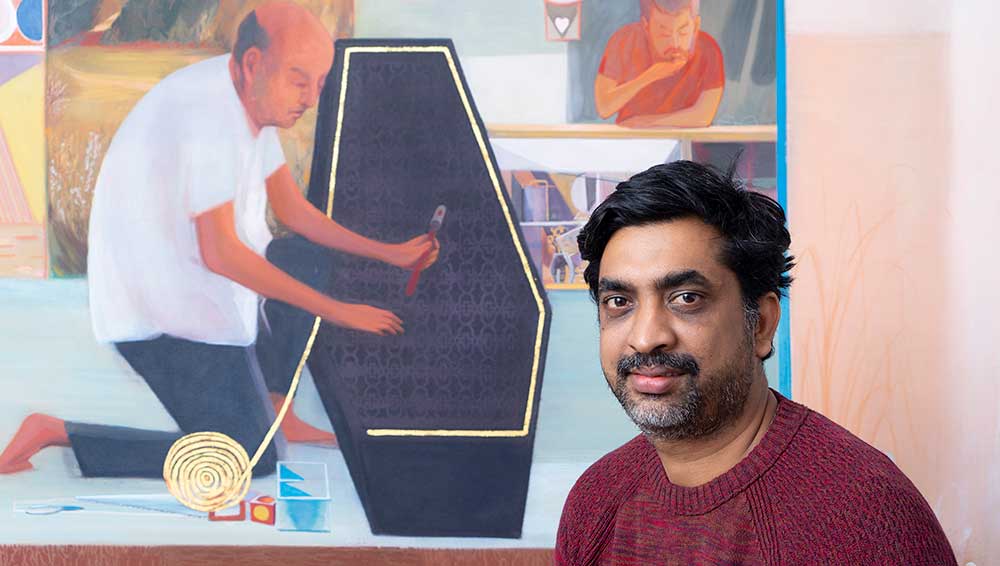
Portrait of Mahesh Baliga, 2022. Photo: Manish Mehta. © Mahesh Baliga, courtesy the artist, Project 88, and David Zwirner.
by EMILY SPICER
There is a quiet strangeness to the work of Mahesh Baliga (b1982, Karnataka, India), a stillness that hints at both melancholy and hope. He observes the often overlooked corners of life, the details many of us would pass by, such as an ink stain on a friend’s shirt or the fragments of a broken toy. And yet his paintings are not ordinary. There is a touch of magic realism about them, the sense that a veil has been lifted on the quotidian to reveal the emotional reality beneath. Flowers grow from a man’s chest, a boat with a strangely striped canopy drifts on the sea, a tree sprouts leaves of all shapes and sizes. The real and the imagined mingle almost seamlessly, until the viewer is left questioning what is possible.
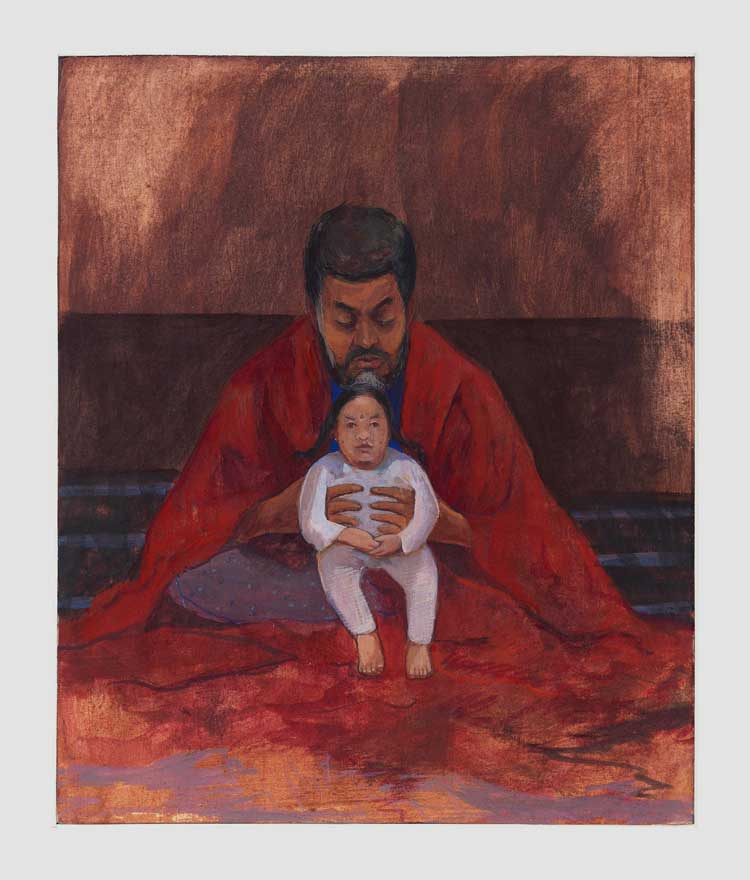
Mahesh Baliga. Acting as father, 2022. Casein on silk board, 12 x 10 in (30.5 x 25.4 cm). © Mahesh Baliga. Courtesy the artist, Project 88, and David Zwirner.
Colour is key to Baliga’s ability to represent layers of meaning in the most subtle terms. He often chooses bright pastel hues, and in doing so emphasises the beauty of the everyday. “Colour is a vehicle to communicate,” he tells me. “I learn a lot every time I paint.” Baliga’s exhibition, Drawn to Remember, at David Zwirner in London, showcases the artist’s adeptness at walking the line between solemnity and joy, the real and the impossible. It is a show concerned with memory and loss, dignity and longing. Baliga spoke to Studio International about his London exhibition, his first solo show outside India, from his studio in Vadodara (also known as Baroda) in India.
ES: Would you say that much of your work is imbued with a sense of sadness?
MB: Definitely. My work starts with pain and sorrow. I can’t be happy and paint. I am happy when the painting is done, but in the initial stage pain and suffering have to be there. That’s the space that excites the artist in me. Ten years ago, I was only making humorous work and seeing everything in a humorous way, but when I lost my mother in 2014 things changed for me. I still feel that someday I will get a call from her. I still have her number, although it might not be working. So that is always going to be a starting point for my work. After 2014, my wife and I were planning for a family, but that was not happening, and I had no money at that time for expensive treatments. This collected sorrow becomes my work. When I see the Madonna and child, for example, I’m not seeing it from an art historical perspective, I am interested only in the child and how it looks. I have to create something I don’t have. My work is autobiographical.
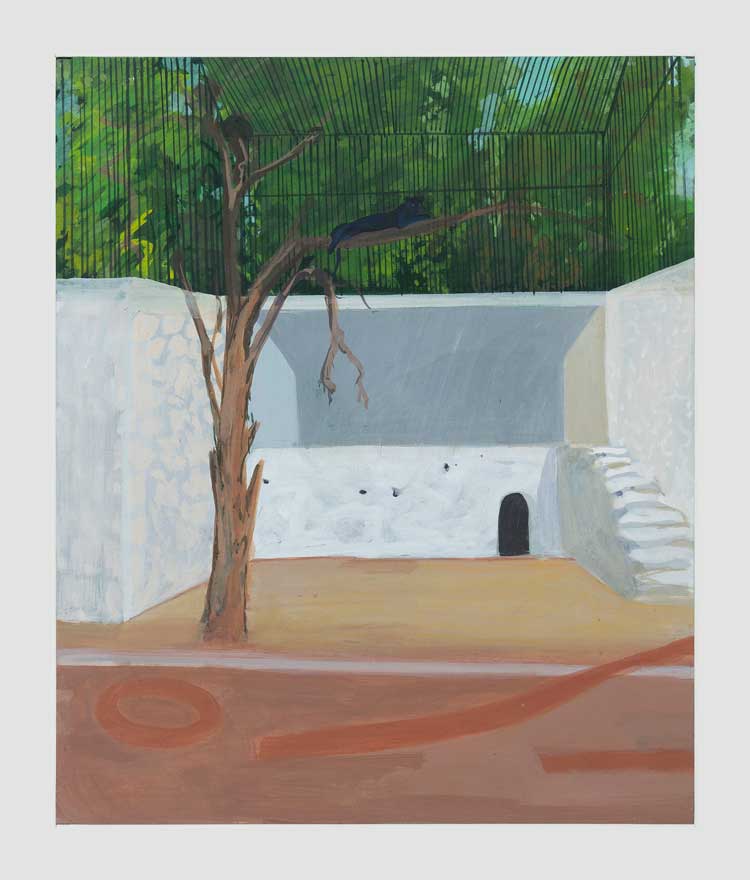
Mahesh Baliga. Jaguar, 2022. Casein on board, 12 x 10 in (30.5 x 25.4 cm). © Mahesh Baliga. Courtesy the artist, Project 88, and David Zwirner.
ES: That sense of sorrow seems present when you paint animals, too.
MB: When I see them, I feel my own condition. I made a painting of deer and lions in 2010. We have a zoo here that has a deer park and opposite to that there is a lion cage. In between, humans would pass by. Humans have so much power. They shifted 170 animals from there to a new park and 55 died. They put monkeys in a lion cage, and they put different birds together that can’t stay together. It’s like having a roommate from another country and you can’t speak the same language. They make a strange environment for the animals. I don’t know why they do it, but it is like the way we build our apartments. They are very strangely done, too.
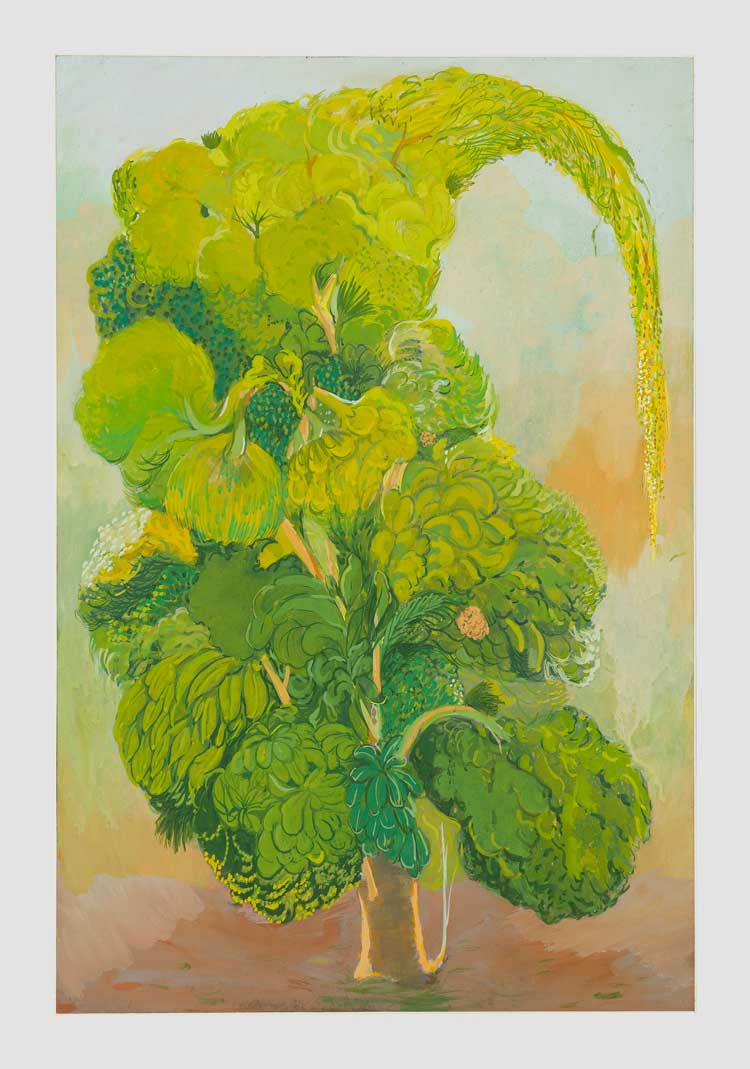
Mahesh Baliga. Pagla gach, 2022. Casein on board, 24 x 16 in (61 x 40.6 cm). © Mahesh Baliga. Courtesy the artist, Project 88, and David Zwirner.
ES: Tell me about the painting Pagla Gach. It looks almost surreal.
MB: Pagla gach is Bengali for mad tree. The scientific name is Pterygota alata. I was visiting the Botanic Garden in Kolkata and I was fascinated by the leaves. Each leaf is different from the other; they don’t replicate each other. The shape changes, the scale also changes, everything changes. This tree gave me a chance to put everything in one space.
ES: I have noticed that you have painted quite a few images of boats at sea, which seem rather different from your other works.
MB: When the lockdown was happening, there were migrants who were wandering from one place to the other by sea and they were not accepted. We were in lockdown at home, safe, but they were wandering. I saw an image of these people, and it reminded me of a painting of a Romantic painting of slaves on a boat. I thought of painting that helpless condition, of making it memorable, because this shouldn’t happen to human beings. They have to leave their country; it’s very tough and painful. For me, it’s about the pain of the others.
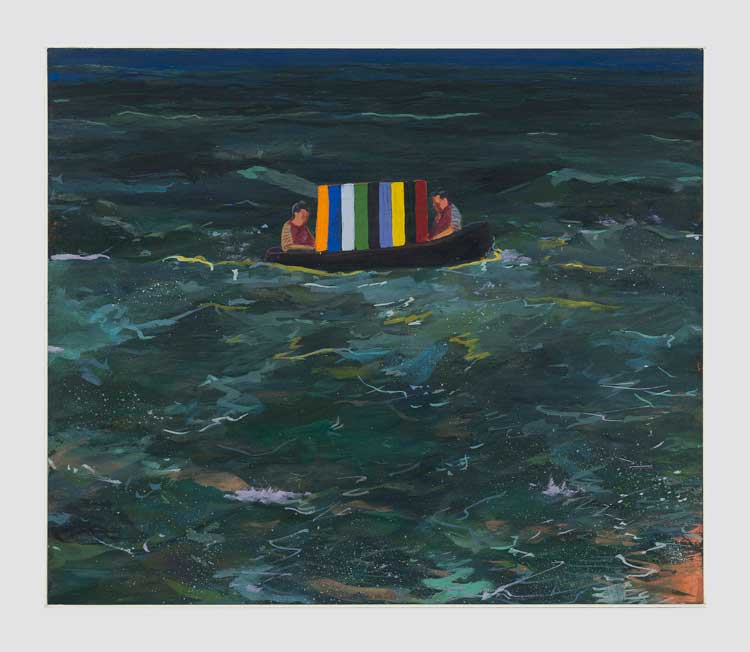
Mahesh Baliga. Diversion, 2022 Casein on board, 10 x 12 in (25.4 x 30.5 cm). © Mahesh Baliga. Courtesy the artist, Project 88, and David Zwirner.
ES: Can you tell me about Return? It looks like the base of a statuette, but the shape is quite haunting.
MB: It’s the back of a small sculpture of Shiva. We have three main gods in our mythology, one is the creator, Brahma. Then you have the destroyer, Shiva, and Vishnu the protector. They have turned their back to us. They’re not listening.
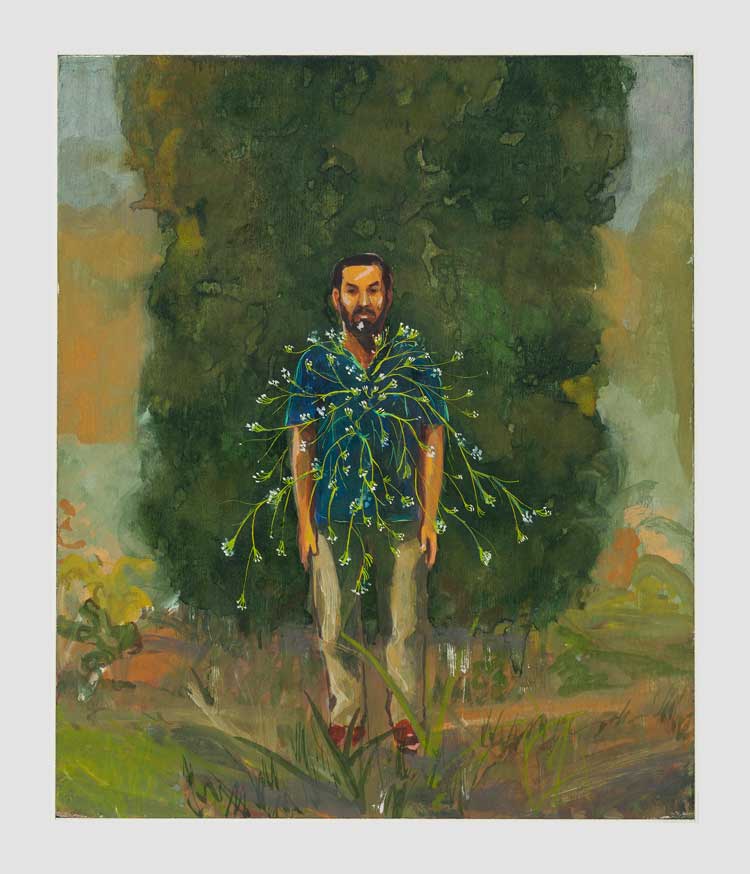
Mahesh Baliga. Flowering self, 2022. Casein on board, 12 x 10 in (30.5 x 25.4 cm). © Mahesh Baliga. Courtesy the artist, Project 88, and David Zwirner.
ES: What is the symbolism of The Flowering Self? Is it a self-portrait?
MB: The Flowering Self shows the male papaya tree, which only flowers, it doesn't fruit. I have superimposed myself on it because I am like a male papaya tree. It’s a painful painting, but there is some kind of satire too.
ES: I know that you often paint family and friends. Can you tell me about Aveek Cutting His Nails, and what this work means to you?
MB: He was a dear friend. I knew him only for two and a half years maximum, but I learned a lot from him. He would always talk about art and painting, and I would talk about whatever I want. I painted him cutting his nails. It’s almost like he’s still there, it’s that kind of feeling. He wanted a minimal room, which never happened because it was always so full of books. So, I painted him in a room the way he would have wanted it.
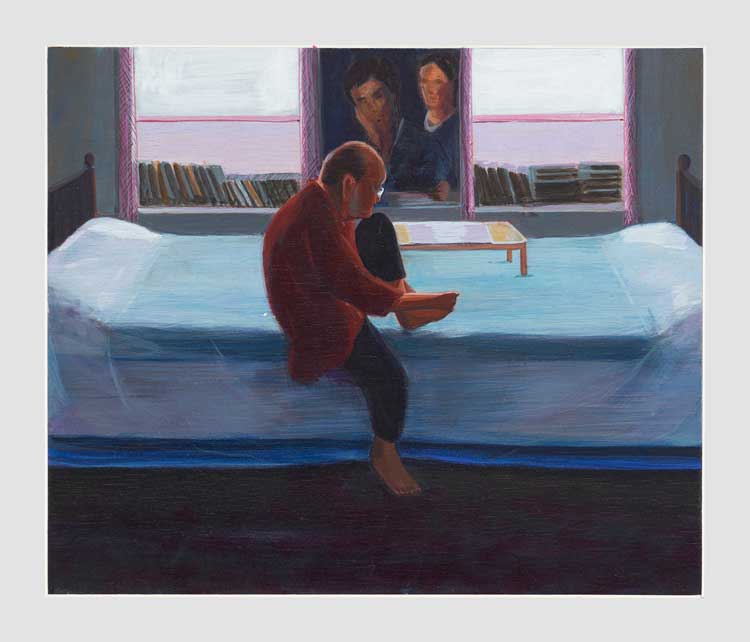
Mahesh Baliga. Aveek cutting nails, 2022. Casein on board
10 x 12 in (25.4 x 30.5 cm). © Mahesh Baliga. Courtesy the artist, Project 88, and David Zwirner.
ES: How did you meet?
MB: When I met him for the first time, we didn’t gel very fast. He talked with me as an artist. I thought, he’s a writer, so I will ask him to write about my work. In 2019, I showed him my works, showed him my show, It’s A Normal Day, and he was very excited to see the paintings. Then the conversation started, and we published it in a book. I learned so many things from him, about sensibility and sensation, things I had never thought of in those terms. He gave me another way of looking at the work and thinking about time. I don’t paint the shadows, basically. I paint them like miniature paintings. There are no shadows in miniature paintings. Whenever you look at my work, you don’t see a specific time. It’s about the strange time.
• Mahesh Baliga: Drawn to Remember is at David Zwirner, London, until 28 May 2022.